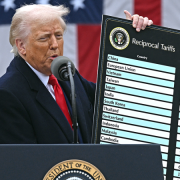The DAX Index has bounced back in the past few weeks as concerns about the ongoing trade conflict between the US and its top trading partners rose. After bottoming at €18,460 earlier this year, the index returned to €21,310. It remains much lower than the year-to-date high of €23,445. Is it a buy ahead of the ECB decision?
ECB interest rate decision
The German DAX and other European indices will be in the spotlight as market participants wait for more support from the European Central Bank (ECB).
Economists anticipate that the central bank will slash interest rates by 0.25% in this meeting as concerns about economic growth continued. If this happens, interest rates will be slashed from 2.5% to 2.2%. Unlike the Fed, the ECB has been more dovish and slashed interest rates several times since last year.
The odds of another ECB cut accelerated after Wednesday’s latest European inflation data. These numbers revealed that the headline consumer inflation remained at 2.2% in March, while the core CPI remained at 2.4% in the same period.
Analysts believe the ongoing trade war will lead to slow economic growth in Europe this year. In a note, a Bloomberg analyst said:
“The ECB is facing a world that’s significantly different from the last time it met, as US tariffs become a reality, and monetary policy for the euro area will have to adapt.”
The dovish view has pushed German bond yields downwards. Data shows that the yield of the German ten-year bonds dropped from 2.93% in March to the current 2.495%. The five-year yield also dropped to 2.04%. Historically, the stock market does well when bond yields are falling.
The ECB is also likely concerned about the strength of the euro. Data shows that the EUR/USD pair has soared to 1.1400, up sharply from the year-to-date low of 1.1075
While the stronger euro will help to lower inflation, it will impact European exporters by making goods more expensive abroad. This is a key issue because these goods have already become expensive because of Donald Trump’s tariffs.
Top DAX laggards and gainers
The worst laggards in the German DAX are companies exposed to the United States, which are now forced to pay higher tariffs.
Porsche’s share price has crashed by over 24% this year, making it the top laggard in the DAX index. It is more exposed to US tariffs because it has become its most important market in the past few years. It manufactures all vehicles it sells to the US in Germany, meaning that a 25% tariff will hurt its business.
The other top laggards in the DAX index are firms like Adidas, Merck, MTU Aero, Siemens Healthineers, BMW, and Daimler Truck.
On the other hand, the top performers in the index are Rheinmetall, Commerzbank, Heidelberg Cement, Deutsche Bank, and Deutsche Boerse.
DAX index technical analysis
The daily chart shows that the DAX index peaked at €23,445 earlier this year and then dropped to a low of €18,497. It then bounced back to the current €21,310, a 15% surge.
The index remains slightly below the 50-day and 100-day Exponential Moving Averages (EMA). It has also retested the key strong pivot reverse point at €21,250.
Therefore, there is still a risk that the DAX Index will retreat as the trade jitters remain. If this happens, the next key point to watch will be the major S/R pivot point at €20,000. A move above the 50-day moving average at €21,737 will invalidate the bearish outlook.
The post DAX Index analysis ahead of the ECB decision: is it a buy? appeared first on Invezz






